Synergistic Effects of Drivers on Spatiotemporal Changes in Carbon and Water Use Efficiency in Irrigated Cropland Ecosystems
Abstract
1. Introduction
2. Materials and Methods
2.1. Research Area
2.2. Data
2.3. Methods
2.3.1. Carbon and Water Use Efficiency
2.3.2. Sen + MK Trends Analysis
2.3.3. Dual-Type Randomized Extraction Algorithm
2.3.4. Optimal Parameters XGBoost Model
2.3.5. SHAP Explanatory Model
2.3.6. Calculation of Importance Index
3. Results
3.1. Spatiotemporal Changes in Cropland CWUE, GPP, NPP, and ET
3.1.1. Spatiotemporal Changes in Cropland CWUE
3.1.2. Spatiotemporal Changes in Cropland GPP, NPP, and ET
3.1.3. Interannual Variations in Average Annual of Cropland CWUE, GPP, NPP, and ET
3.2. A Quantitative Evaluation of the Impact of Irrigation on CWUE in Cropland
3.2.1. A Dual-Type Randomized Extraction Algorithm to Extract the Study Area
3.2.2. Quantitative Evaluation of CWUE for Irrigated and Non-Irrigated Cropland
3.3. Spatial Drivers and Synergistic Mechanisms of Irrigated Cropland CWUE
3.3.1. Spatial Distribution of SHAP Values of Driving Factors and Irrigated Cropland CWUE
3.3.2. Dominant Factors and Spatial Distribution of CWUE in Irrigated Cropland
3.3.3. Synergistic Effects of Drivers on Irrigated Cropland CWUE
4. Discussion
4.1. Spatiotemporal Variations in Cropland CWUE
4.2. Impact of Irrigation on Cropland CWUE
4.3. Impact of Drivers on CWUE
4.4. Limitations and Perspectives of This Study
5. Conclusions
Author Contributions
Funding
Data Availability Statement
Conflicts of Interest
References
- Omar, P.J.; Gupta, P.; Wang, Q. Exploring the rise of AI-based smart water management systems. AQUA—Water Infrastruct. Ecosyst. Soc. 2023, 72, iii–iv. [Google Scholar] [CrossRef]
- Sinclair, T.R.; Rufty, T.W. Nitrogen and water resources commonly limit crop yield increases, not necessarily plant genetics. Glob. Food Secur.-Agric. Policy Econ. Environ. 2012, 1, 94–98. [Google Scholar] [CrossRef]
- Song, Y.; Guo, Y.H.; Li, S.J.; Li, W.Y.P.; Jin, X.L. Elevated CO2 concentrations contribute to a closer relationship between vegetation growth and water availability in the Northern Hemisphere mid-latitudes. Environ. Res. Lett. 2024, 19, 084013. [Google Scholar] [CrossRef]
- Zeleke, K.T.; Nendel, C. Analysis of options for increasing wheat (Triticum aestivum L.) yield in south-eastern Australia: The role of irrigation, cultivar choice and time of sowing. Agric. Water Manag. 2016, 166, 139–148. [Google Scholar] [CrossRef]
- Li, J.P.; Xu, X.X.; Lin, G.; Wang, Y.Q.; Liu, Y.; Zhang, M.; Zhou, J.Y.; Wang, Z.M.; Zhang, Y.H. Micro-irrigation improves grain yield and resource use efficiency by co-locating the roots and N-fertilizer distribution of winter wheat in the North China Plain. Sci. Total Environ. 2018, 643, 367–377. [Google Scholar] [CrossRef] [PubMed]
- Stagno, F.; Brambilla, M.; Roccuzzo, G.; Assirelli, A. Water Use Efficiency in a Deficit-Irrigated Orange Orchard. Horticulturae 2024, 10, 498. [Google Scholar] [CrossRef]
- Breckner, M.; Sunde, U. Temperature extremes, global warming and armed conflict: New insights from high resolution data. World Dev. 2019, 123, 104624. [Google Scholar] [CrossRef]
- Siddik, M.A.; Zhang, J.; Chen, J.; Qian, H.Y.; Jiang, Y.; Raheem, A.K.; Deng, A.X.; Song, Z.W.; Zheng, C.Y.; Zhang, W.J. Responses of indica rice yield and quality to extreme high and low temperatures during the reproductive period. Eur. J. Agron. 2019, 106, 30–38. [Google Scholar] [CrossRef]
- Zhao, C.; Liu, B.; Piao, S.; Wang, X.; Lobell, D.B.; Huang, Y.; Huang, M.; Yao, Y.; Bassu, S.; Ciais, P.; et al. Temperature increase reduces global yields of major crops in four independent estimates. Proc. Natl. Acad. Sci. USA 2017, 114, 9326–9331. [Google Scholar] [CrossRef] [PubMed]
- Li, Z.; Cao, T.T.; Sun, Z.Y. Spatial-Temporal Pattern and Driving Factors of Carbon Emission Intensity of Main Crops in Henan Province. Sustainability 2022, 14, 16569. [Google Scholar] [CrossRef]
- Chen, J.D.; Tian, H.W.; Huang, J.; Zhang, J.C.; Zhang, F.M. Climate-driven Yield Variability for Winter Wheat in Henan Province, North China and its Relation to Large-scale Atmospheric Circulation Indices. Int. J. Plant Prod. 2021, 15, 79–91. [Google Scholar] [CrossRef]
- Gao, J.; Wang, L.C. Embedding spatiotemporal changes in carbon storage into urban agglomeration ecosystem management—A case study of the Yangtze River Delta, China. J. Clean. Prod. 2019, 237, 117764. [Google Scholar] [CrossRef]
- Abidi, A.; Soltani, A.; Zeinali, E. Identifying plant traits to increase wheat yield under irrigated conditions. Heliyon 2024, 10, e31734. [Google Scholar] [CrossRef]
- Hao, D.C.; Su, X.Y.; Xie, H.T.; Bao, X.L.; Zhang, X.D.; Wang, L.F. Effects of tillage patterns and stover mulching on N2O production, nitrogen cycling genes and microbial dynamics in black soil. J. Environ. Manag. 2023, 345, 118458. [Google Scholar] [CrossRef]
- Migliavacca, M.; Musavi, T.; Mahecha, M.D.; Nelson, J.A.; Knauer, J.; Baldocchi, D.D.; Perez-Priego, O.; Christiansen, R.; Peters, J.; Anderson, K.; et al. The three major axes of terrestrial ecosystem function. Nature 2021, 598, 468–472. [Google Scholar] [CrossRef] [PubMed]
- Hua, L.; Zhang, F.; Sun, R.; Yu, X.; Ma, H. Synergy of carbon and water use efficiencies in the Huai River Basin. Ecol. Indic. 2024, 160, 111874. [Google Scholar] [CrossRef]
- Wang, Y.; Gao, G.; Huang, Y.; Wang, Z.; Fu, B. Ecosystem water use efficiency and carbon use efficiency respond oppositely to vegetation greening in China’s Loess Plateau. Sci. Total Environ. 2025, 964, 178575. [Google Scholar] [CrossRef]
- Cai, X.; Li, L.; Fisher, J.B.; Zeng, Z.; Zhou, S.; Tan, X.; Liu, B.; Chen, X. The responses of ecosystem water use efficiency to CO2, nitrogen deposition, and climatic drivers across China. J. Hydrol. 2023, 622, 129696. [Google Scholar] [CrossRef]
- Wang, D.; Qin, W.; Xu, H.; Shan, Z.; Yu, X. Assessing the response of water use efficiency to climate variability and land-use changes in the mountainous area of North China. For. Ecol. Manag. 2023, 530, 120780. [Google Scholar] [CrossRef]
- Xing, W.; Yang, L.; Wang, W.; Yu, Z.; Shao, Q.; Xu, S.; Fu, J. Environmental controls on carbon and water fluxes of a wheat-maize rotation cropland over the Huaibei Plain of China. Agric. Water Manag. 2023, 283, 108310. [Google Scholar] [CrossRef]
- Chen, Z.; Yu, G. Spatial variations and controls of carbon use efficiency in China’s terrestrial ecosystems. Sci. Rep. 2019, 9, 19516. [Google Scholar] [CrossRef] [PubMed]
- Chakraborty, A.; Sekhar, M.; Rao, L. The fate of vegetation carbon stocks of India: Insights from a remote-sensed evaluation of carbon use efficiency. Ecol. Inform. 2023, 78, 102374. [Google Scholar] [CrossRef]
- Simone, F.; Christoforos, P.; Jakob, Z.; Sebastian, L. Modelling carbon sources and sinks in terrestrial vegetation. New Phytol. 2019, 221, 652–668. [Google Scholar]
- Xiao, B.; Bai, X.; Tan, Q.; Li, Y.; Zhao, C.; Luo, G.; Wu, L.; Chen, F.; Li, C.; Ran, C.; et al. Nitrogen Deposition Enhances the Positive Contribution of CO2 Fertilization to China’s Carbon and Water Use Efficiencies. Land 2023, 12, 413. [Google Scholar] [CrossRef]
- Xiao, B.; Bai, X.; Zhao, C.; Tan, Q.; Li, Y.; Luo, G.; Wu, L.; Chen, F.; Li, C.; Ran, C.; et al. Responses of carbon and water use efficiencies to climate and land use changes in China’s karst areas. J. Hydrol. 2023, 617, 128968. [Google Scholar] [CrossRef]
- Chen, Z.; Yu, G.; Wang, Q. Magnitude, pattern and controls of carbon flux and carbon use efficiency in China’s typical forests. Glob. Planet. Change 2019, 172, 464–473. [Google Scholar] [CrossRef]
- Gang, C.C.; Wang, Z.N.; You, Y.F.; Liu, Y.; Xu, R.T.; Bian, Z.H.; Pan, N.Q.; Gao, X.R.; Chen, M.X.; Zhang, M. Divergent responses of terrestrial carbon use efficiency to climate variation from 2000 to 2018. Glob. Planet. Change 2022, 208, 103709. [Google Scholar] [CrossRef]
- Wei, W.; Li, H.; Wang, B.; Zhang, K. Rain- and water-use efficiencies of a shrub ecosystem and its resilience to drought in the Central Asia region during 2000–2014. Glob. Ecol. Conserv. 2019, 17, e00595. [Google Scholar] [CrossRef]
- Kim, D.; Baik, J.; Umair, M.; Choi, M. Water use efficiency in terrestrial ecosystem over East Asia: Effects of climate regimes and land cover types. Sci. Total Environ. 2021, 773, 145519. [Google Scholar] [CrossRef]
- Li, X.H.; Zha, T.S.; Liu, P.; Tian, Y.; Jia, X.; Bourque, C.P.A.; Jin, C.; Yang, R.Z.; Jiang, Y.; Hao, S.R. Multi-year trend and interannual variability in soil respiration measurements collected in an urban forest ecosystem in Beijing, China. Agric. For. Meteorol. 2022, 316, 108877. [Google Scholar] [CrossRef]
- Sun, Y.; Piao, S.; Huang, M.; Ciais, P.; Zeng, Z.; Cheng, L.; Li, X.; Zhang, X.; Mao, J.; Peng, S.; et al. Global patterns and climate drivers of water-use efficiency in terrestrial ecosystems deduced from satellite-based datasets and carbon cycle models. Glob. Ecol. Biogeogr. 2016, 25, 311–323. [Google Scholar] [CrossRef]
- Wang, T.; Tang, X.; Zheng, C.; Gu, Q.; Wei, J.; Ma, M. Differences in ecosystem water-use efficiency among the typical croplands. Agric. Water Manag. 2018, 209, 142–150. [Google Scholar] [CrossRef]
- Shen, Y.; Zhang, Y.; Scanlon, B.R.; Lei, H.; Yang, D.; Yang, F. Energy/water budgets and productivity of the typical croplands irrigated with groundwater and surface water in the North China Plain. Agric. For. Meteorol. 2013, 181, 133–142. [Google Scholar] [CrossRef]
- Wang, Y.; Zhou, L.; Ping, X.; Jia, Q.; Li, R. Ten-year variability and environmental controls of ecosystem water use efficiency in a rainfed maize cropland in Northeast China. Field Crops Res. 2018, 226, 48–55. [Google Scholar] [CrossRef]
- Elfarkh, J.; Johansen, K.; El Hajj, M.M.; Almashharawi, S.K.; McCabe, M.F. Evapotranspiration, gross primary productivity and water use efficiency over a high-density olive orchard using ground and satellite based data. Agric. Water Manag. 2023, 287, 108423. [Google Scholar] [CrossRef]
- Li, G.C.; Chen, W.; Li, R.R.; Zhang, X.P.; Liu, J.L. Assessing the spatiotemporal dynamics of ecosystem water use efficiency across China and the response to natural and human activities. Ecol. Indic. 2021, 126, 107680. [Google Scholar] [CrossRef]
- Zhao, J.; Xu, T.; Xiao, J.; Liu, S.; Mao, K.; Song, L.; Yao, Y.; He, X.; Feng, H. Responses of Water Use Efficiency to Drought in Southwest China. Remote Sens. 2020, 12, 199. [Google Scholar] [CrossRef]
- Fang, Q.X.; Ma, L.; Green, T.R.; Yu, Q.; Wang, T.D.; Ahuja, L.R. Water resources and water use efficiency in the North China Plain: Current status and agronomic management options. Agric. Water Manag. 2010, 97, 1102–1116. [Google Scholar] [CrossRef]
- Zhang, X.; Chen, S.; Sun, H.; Wang, Y.; Shao, L. Water use efficiency and associated traits in winter wheat cultivars in the North China Plain. Agric. Water Manag. 2010, 97, 1117–1125. [Google Scholar] [CrossRef]
- Sun, H.-Y.; Liu, C.-M.; Zhang, X.-Y.; Shen, Y.-J.; Zhang, Y.-Q. Effects of irrigation on water balance, yield and WUE of winter wheat in the North China Plain. Agric. Water Manag. 2006, 85, 211–218. [Google Scholar] [CrossRef]
- Shao, L.; Zhang, X.; Hideki, A.; Tsuji, W.; Chen, S. Effects of defoliation on grain yield and water use of winter wheat. J. Agric. Sci. 2010, 148, 191–204. [Google Scholar] [CrossRef]
- Li, H.; Liu, H. Climate Change, Farm Irrigation Facilities and Agriculture Total Factor Productivity: Evidence from China. Sustainability 2023, 15, 2889. [Google Scholar] [CrossRef]
- Jha, S.K.; Ramatshaba, T.S.; Wang, G.; Liang, Y.; Liu, H.; Gao, Y.; Duan, A. Response of growth, yield and water use efficiency of winter wheat to different irrigation methods and scheduling in North China Plain. Agric. Water Manag. 2019, 217, 292–302. [Google Scholar]
- Partridge, T.; Winter, J.; Kendall, A.; Basso, B.; Pei, L.; Hyndman, D. Irrigation benefits outweigh costs in more US croplands by mid-century. Commun. Earth Environ. 2023, 4, 274. [Google Scholar] [CrossRef]
- Gao, P.; Xie, Y.; Song, C.; Cheng, C.; Ye, S. Exploring detailed urban-rural development under intersecting population growth and food production scenarios: Trajectories for China’s most populous agricultural province to 2030. J. Geogr. Sci. 2023, 33, 222–244. [Google Scholar] [CrossRef]
- Ling, M.; Qi, T.; Li, W.; Yu, L.; Xia, Q. Simulating and predicting the development trends of the water–energy–food–ecology system in Henan Province, China. Ecol. Indic. 2024, 158, 111513. [Google Scholar] [CrossRef]
- Wang, A.; Zhang, M.M.; Chen, E.Q.; Zhang, C.; Han, Y.J. Impact of seasonal global land surface temperature (LST) change on gross primary production (GPP) in the early 21st century. Sustain. Cities Soc. 2024, 110, 105572. [Google Scholar] [CrossRef]
- Chen, W.; Li, G.; Wang, D.; Yang, Z.; Wang, Z.; Zhang, X.; Peng, B.; Bi, P.; Zhang, F. Influence of the ecosystem conversion process on the carbon and water cycles in different regions of China. Ecol. Indic. 2023, 148, 110040. [Google Scholar] [CrossRef]
- Qiu, Y.G.; Zhou, J.; Khandelwal, M.; Yang, H.T.; Yang, P.X.; Li, C.Q. Performance evaluation of hybrid WOA-XGBoost, GWO-XGBoost and BO-XGBoost models to predict blast-induced ground vibration. Eng. Comput. 2022, 38 (Suppl. 5), 4145–4162. [Google Scholar] [CrossRef]
- Ding, H.L.; Wang, R.Q.; Chen, T.T.; Sze, N.N.; Chung, H.; Dong, N. A hybrid approach for modeling bicycle crash frequencies: Integrating random forest based SHAP model with random parameter negative binomial regression model. Accid. Anal. Prev. 2024, 208, 107778. [Google Scholar] [CrossRef]
- Hu, J.; Li, X. A novel prediction model construction and result interpretation method for slope deformation of deep excavated expansive soil canals. Expert Syst. Appl. 2024, 236, 121326. [Google Scholar] [CrossRef]
- Lundberg, S.M.; Erion, G.; Chen, H.; DeGrave, A.; Prutkin, J.M.; Nair, B.; Katz, R.; Himmelfarb, J.; Bansal, N.; Lee, S.I. From local explanations to global understanding with explainable AI for trees. Nat. Mach. Intell. 2020, 2, 56–67. [Google Scholar] [CrossRef] [PubMed]
- Liu, Y.; Xiao, J.; Ju, W.; Zhou, Y.; Wang, S.; Wu, X. Water use efficiency of China’s terrestrial ecosystems and responses to drought. Sci. Rep. 2015, 5, 13799. [Google Scholar] [CrossRef] [PubMed]
- Chuai, X.; Guo, X.; Zhang, M.; Yuan, Y.; Li, J.; Zhao, R.; Yang, W.; Li, J. Vegetation and climate zones based carbon use efficiency variation and the main determinants analysis in China. Ecol. Indic. 2020, 111, 105967. [Google Scholar] [CrossRef]
- Sun, H.; Bai, Y.; Lu, M.; Wang, J.; Tuo, Y.; Yan, D.; Zhang, W. Drivers of the water use efficiency changes in China during 1982-2015. Sci. Total Environ. 2021, 799, 149145. [Google Scholar] [CrossRef]
- Chen, Z.; Yu, G.; Ge, J.; Sun, X.; Hirano, T.; Saigusa, N.; Wang, Q.; Zhu, X.; Zhang, Y.; Zhang, J.; et al. Temperature and precipitation control of the spatial variation of terrestrial ecosystem carbon exchange in the Asian region. Agric. For. Meteorol. 2013, 182–183, 266–276. [Google Scholar] [CrossRef]
- Xiao, J.; Sun, G.; Chen, J.; Chen, H.; Chen, S.; Dong, G.; Gao, S.; Guo, H.; Guo, J.; Han, S.; et al. Carbon fluxes, evapotranspiration, and water use efficiency of terrestrial ecosystems in China. Agric. For. Meteorol. 2013, 182–183, 76–90. [Google Scholar] [CrossRef]
- Ai, Z.; Wang, Q.; Yang, Y.; Manevski, K.; Yi, S.; Zhao, X. Variation of gross primary production, evapotranspiration and water use efficiency for global croplands. Agric. For. Meteorol. 2020, 287, 107935. [Google Scholar] [CrossRef]
- Qin, S.; Ding, J.; Ge, X.; Wang, J.; Wang, R.; Zou, J.; Tan, J.; Han, L. Spatio-Temporal Changes in Water Use Efficiency and Its Driving Factors in Central Asia (2001–2021). Remote Sens. 2023, 15, 767. [Google Scholar] [CrossRef]
- Yang, S.; Zhang, J.; Wang, J.; Zhang, S.; Bai, Y.; Shi, S.; Cao, D. Spatiotemporal variations of water productivity for cropland and driving factors over China during 2001–2015. Agric. Water Manag. 2021, 262, 107328. [Google Scholar] [CrossRef]
- Huang, Y.; Zhang, Z.; Li, Z.; Dai, D.; Li, Y. Evaluation of water use efficiency and optimal irrigation quantity of spring maize in Hetao Irrigation District using the Noah-MP Land Surface Model. Agric. Water Manag. 2022, 264, 107498. [Google Scholar] [CrossRef]
- Allen, R.G.; Pereira, L.S.; Raes, D.; Smith, M. Crop Evapotranspiration-Guidelines for Computing Crop Water Requirements; FAO: Rome, Italy, 1998; FAO Irrigation and Drainage Paper 56. [Google Scholar]
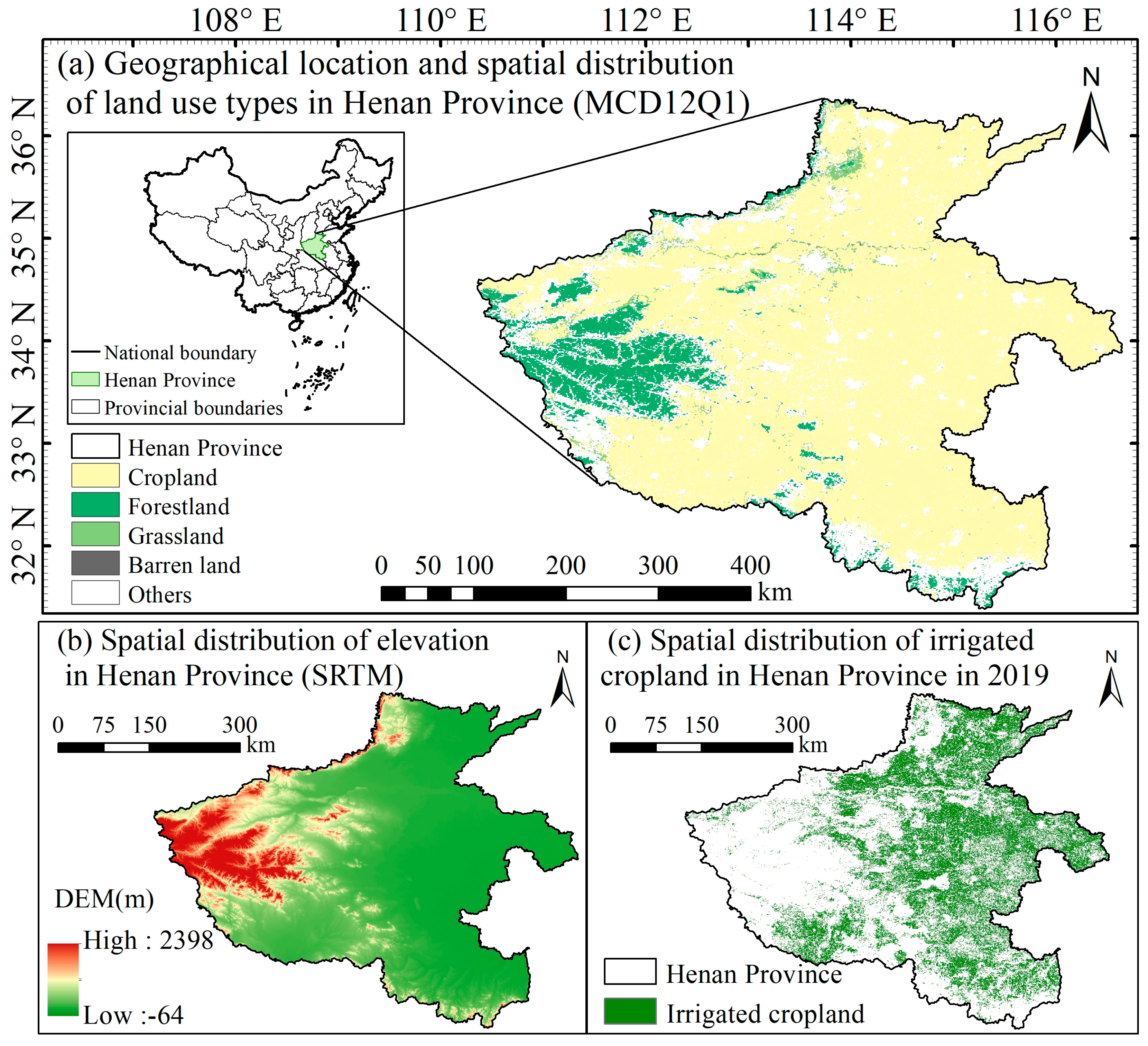
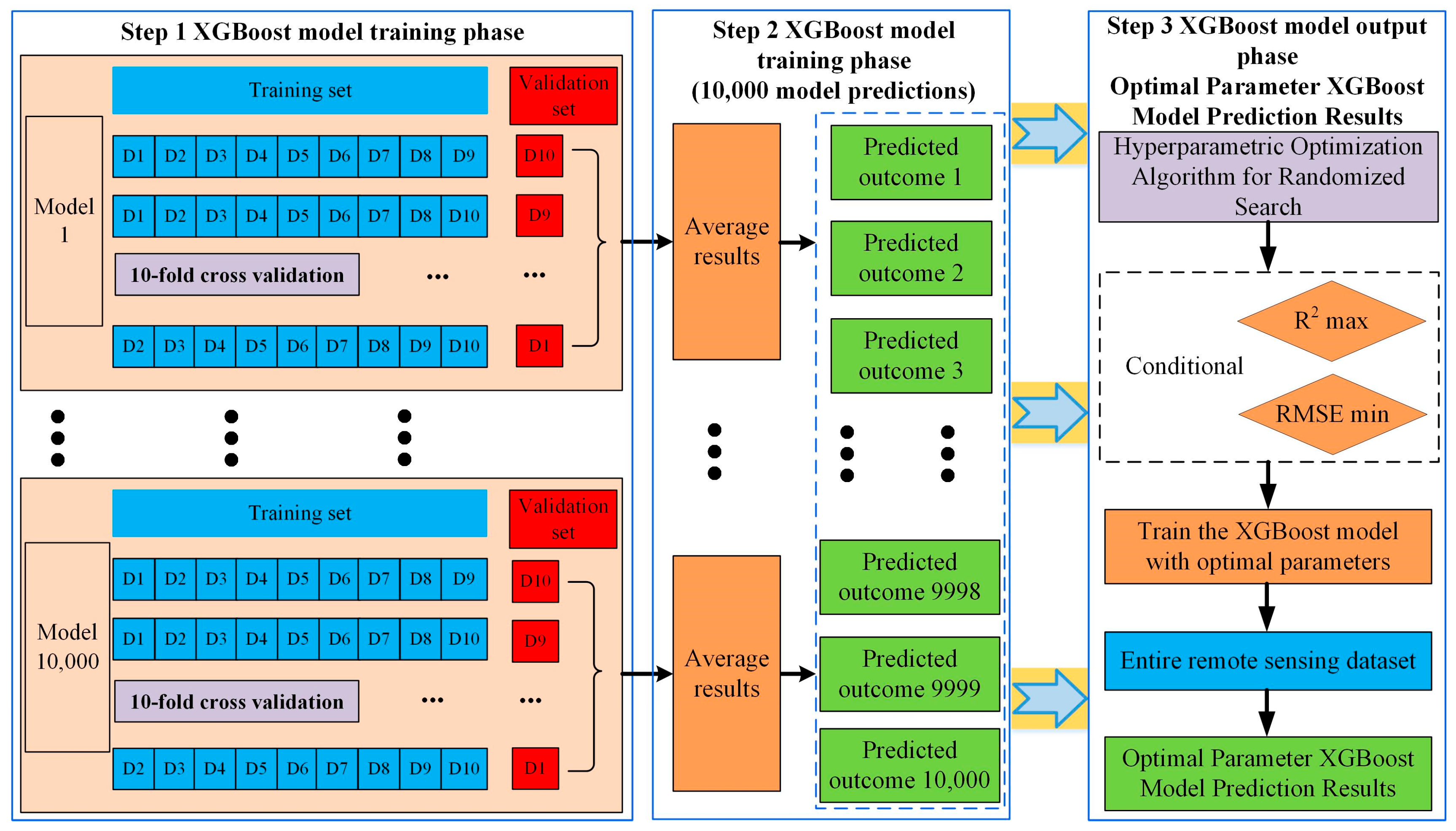
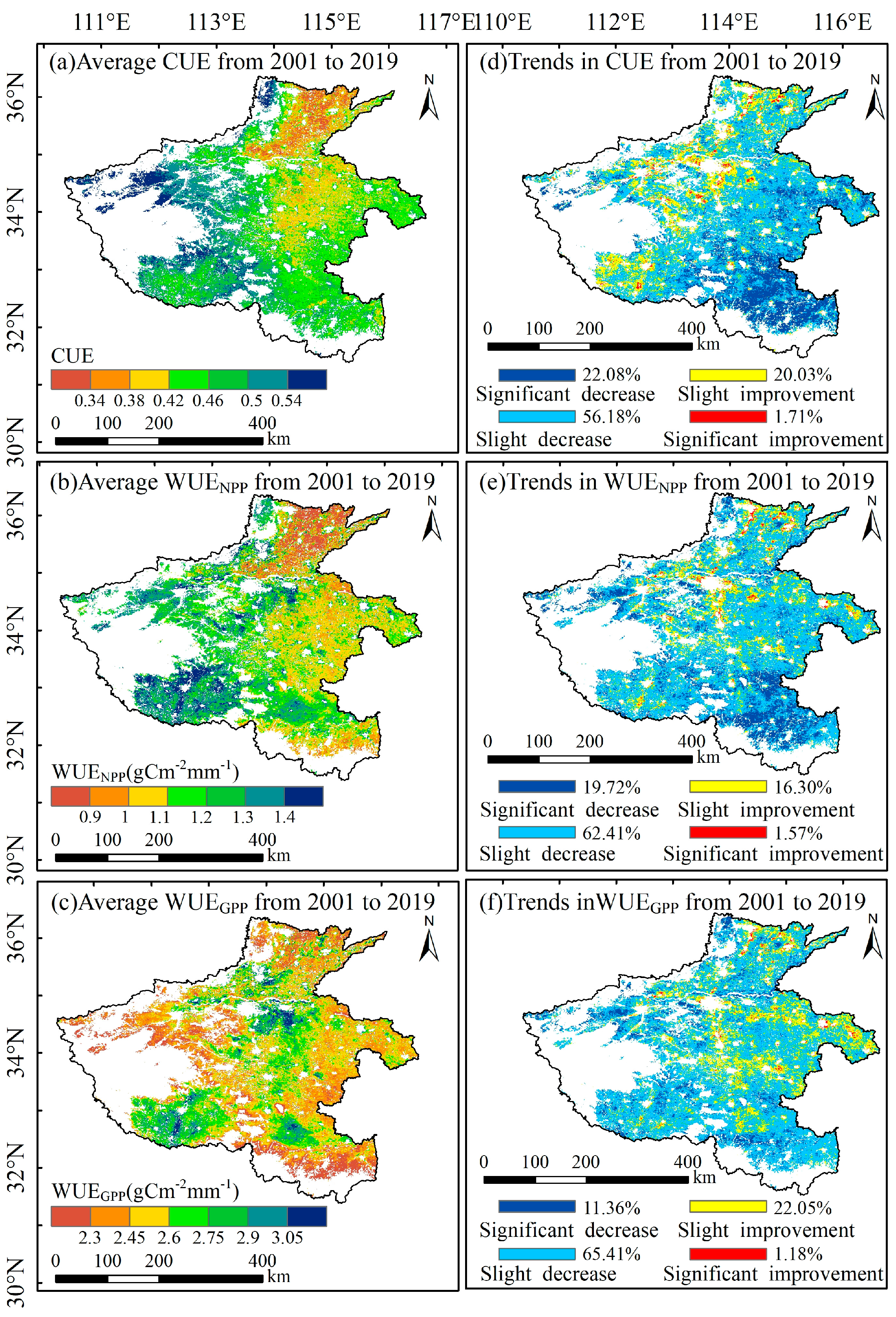
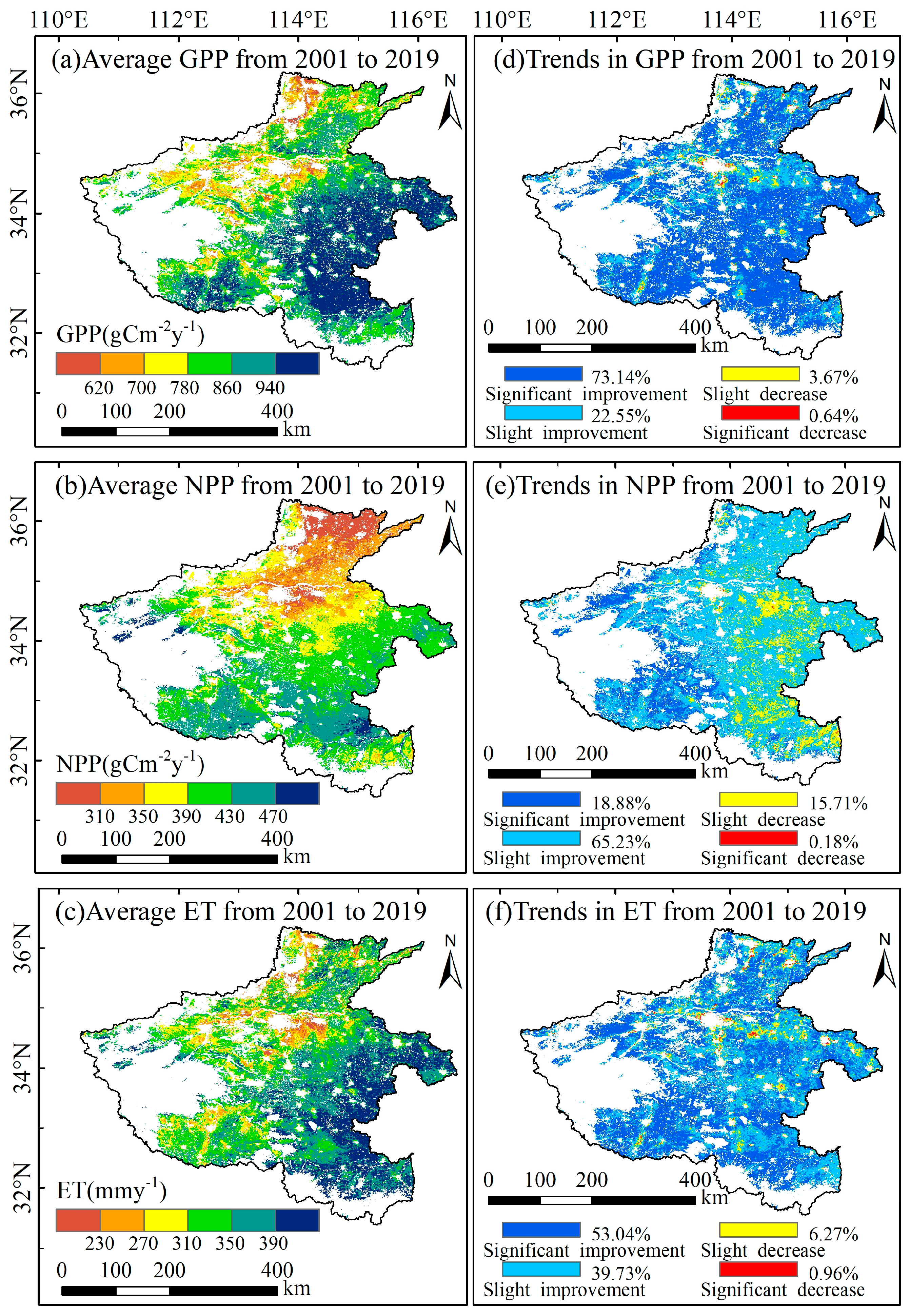
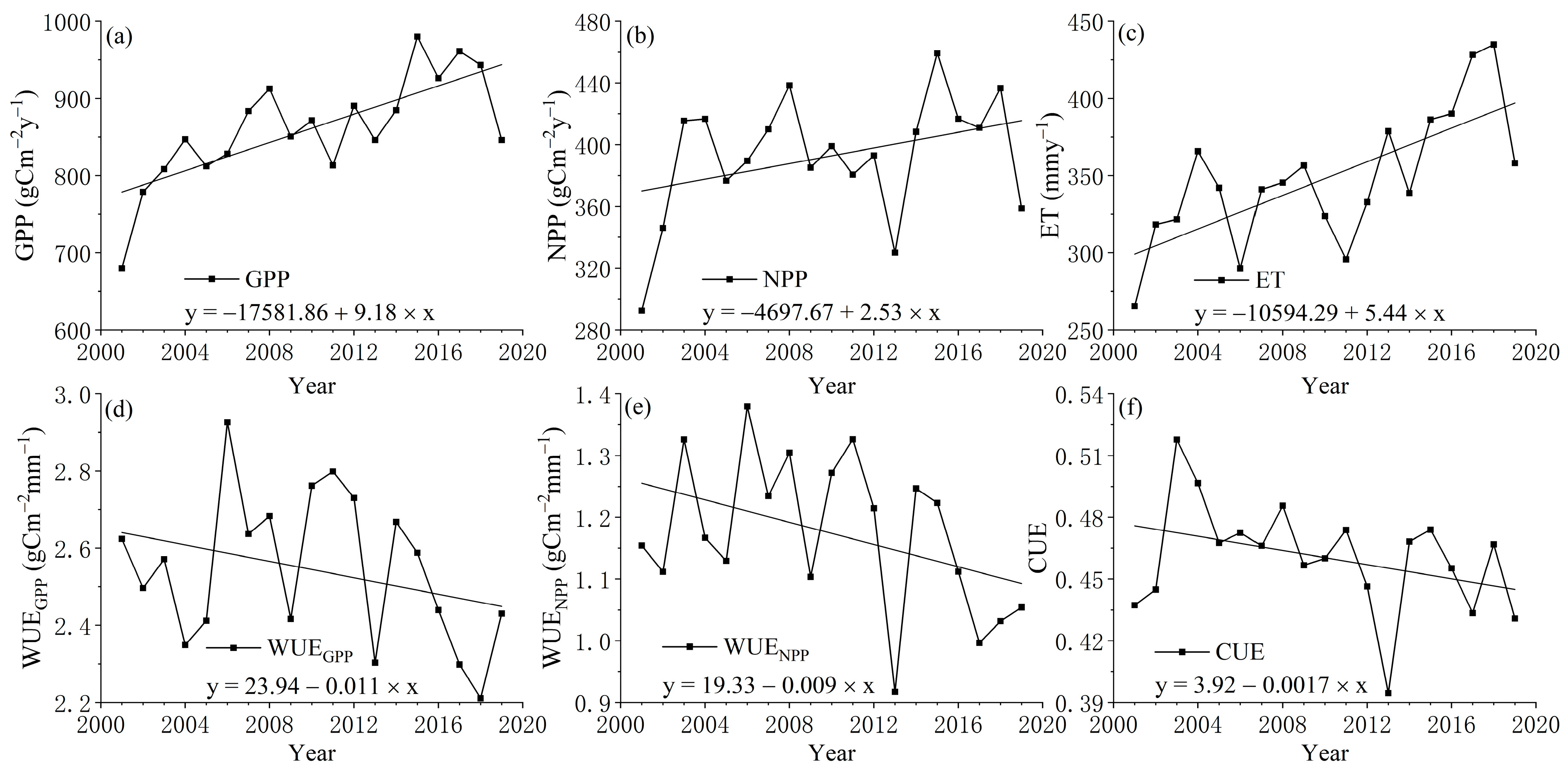

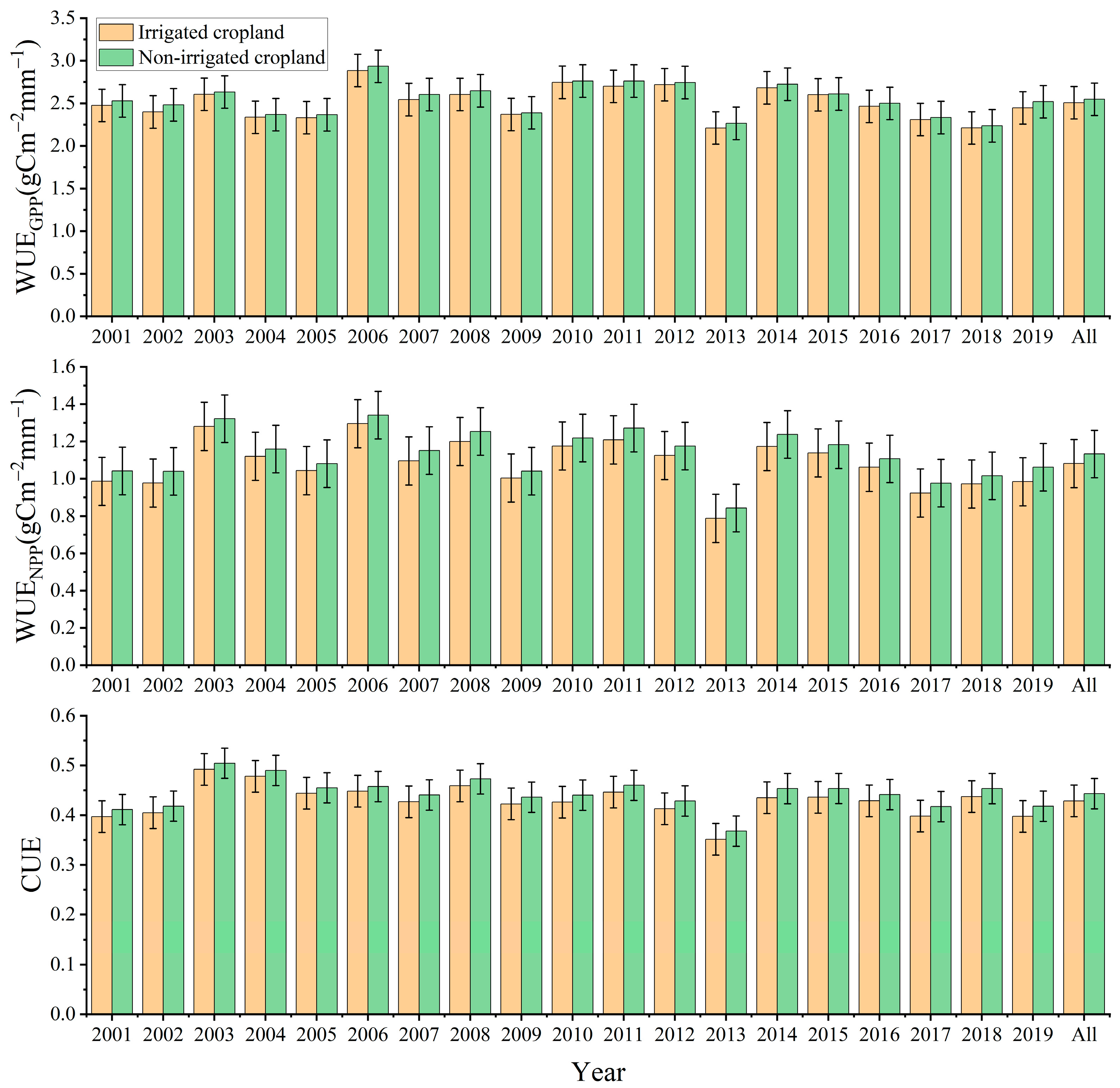

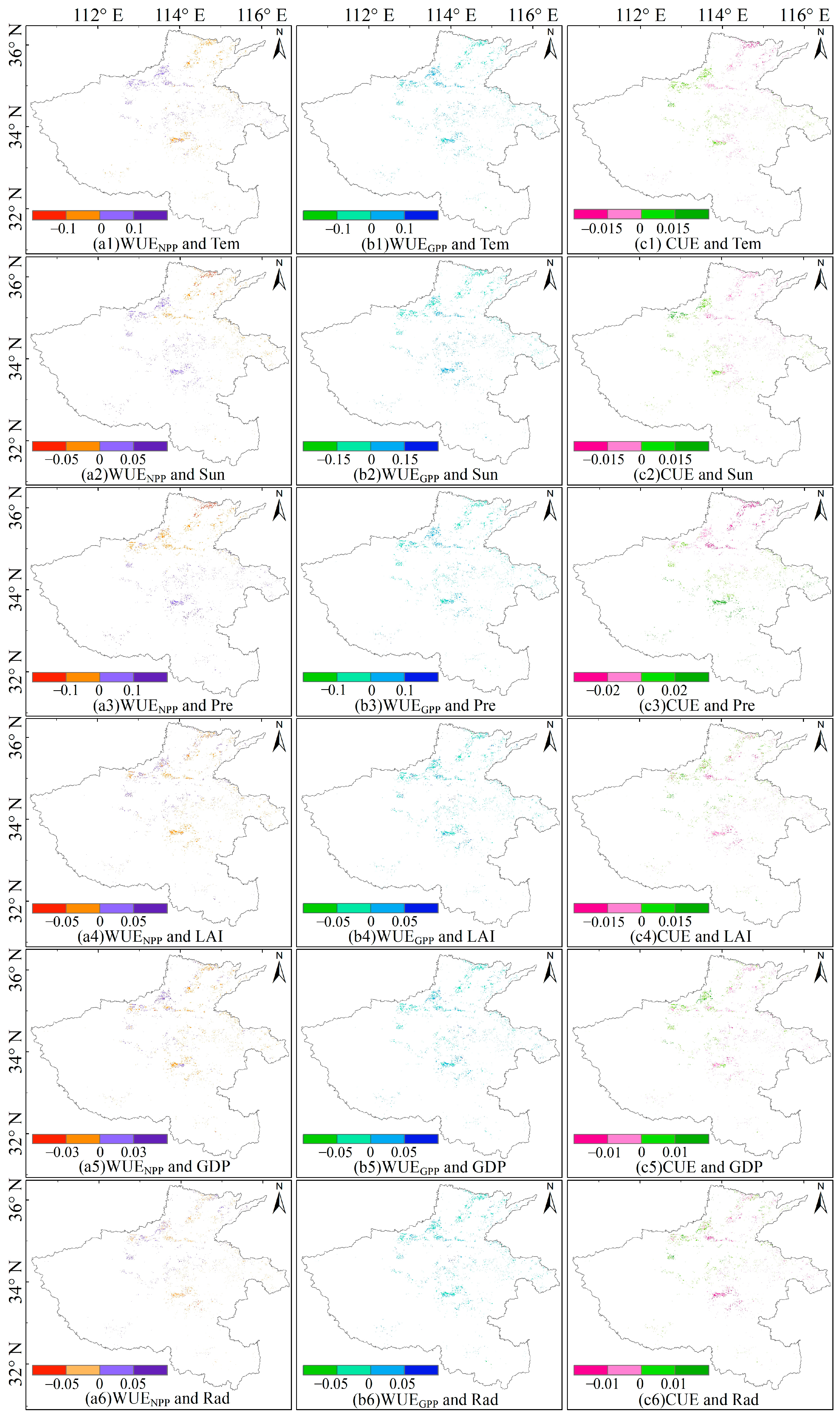
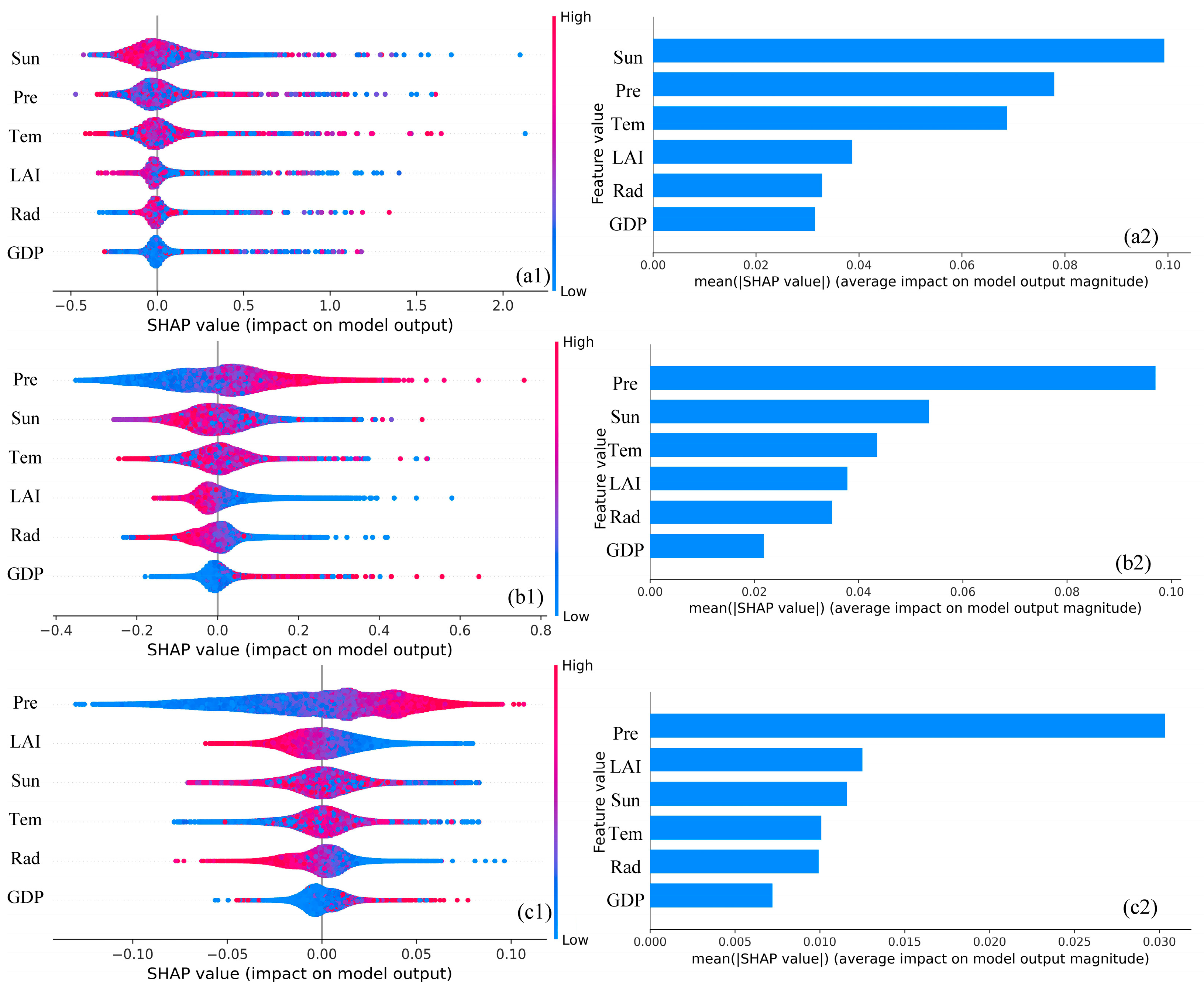
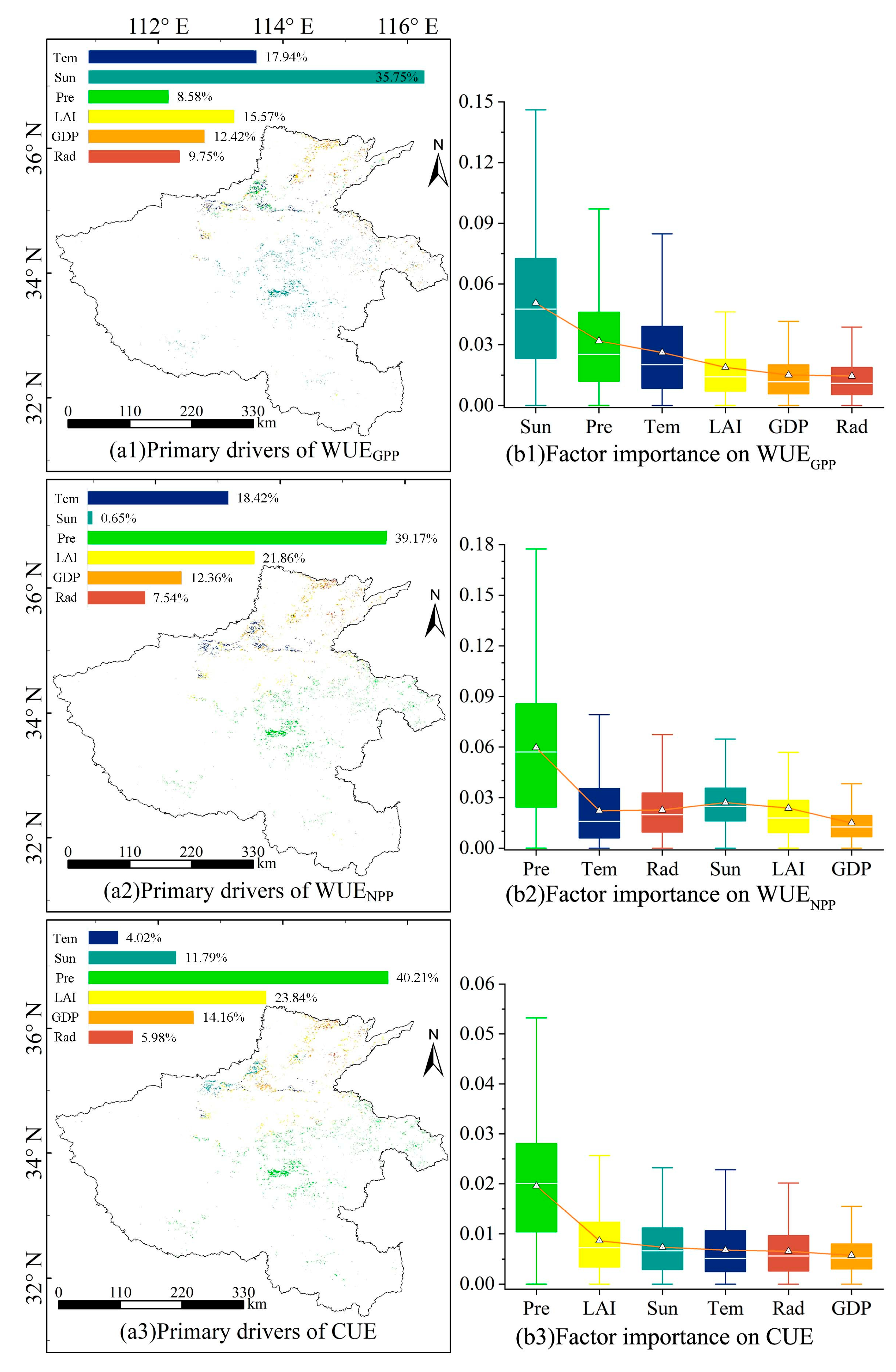

| Dataset | Unit | Time Period | Temporal Resolutions | Spatial Resolutions | Data Source |
|---|---|---|---|---|---|
| GPP | gCm−2y−1 | 2001–2019 | 500 m | 8 days | https://ladsweb.modaps.eosdis.nasa.gov/ |
| NPP | gCm−2y−1 | 2001–2019 | 500 m | 8 days | https://ladsweb.modaps.eosdis.nasa.gov/ |
| ET | mmy−1 | 2001–2019 | 500 m | 8 days | https://glass-product.bnu.edu.cn/introduction/ET.html (accessed on 5 April 2024) |
| LAI | N/A | 2001–2019 | 500 m | 8 days | https://glass-product.bnu.edu.cn/type.html (accessed on 5 May 2024) |
| Land use | N/A | 2001–2019 | 500 m | annual scale | https://doi.org/10.5067/MODIS/MCD12Q1.006 (accessed on 8 June 2024) |
| Temperature | °C | 2001–2019 | 1 km | monthly scale | https://data.tpdc.ac.cn/ |
| Precipitation | mm | 2001–2019 | 1 km | monthly scale | https://data.tpdc.ac.cn/ |
| Rad | N/A | 2001–2019 | 1 km | 8 days | https://www.geodata.cn/ |
| Sun | h | 2001–2019 | 1 km | annual scale | https://www.geodata.cn/ |
| GDP | million USD/km2 | 2001–2019 | 1 km | annual scale | https://doi.org/10.6084/m9.figshare.17004523.v1 (accessed on 10 November 2024) |
| Irrigation | N/A | 2001–2019 | 500 m | annual scale | https://www.nesdc.org.cn/ |
| DEM | m | 2000 | 30 m | N/A | https://www.gscloud.cn/ |
| CWUE | N Estimators | Learning Rate | Max Depth | Subsample | R2 | RMSE |
|---|---|---|---|---|---|---|
| CUE | 454 | 0.1163 | 9 | 0.8912 | 0.8787 | 0.0250 |
| WUENPP | 423 | 0.1206 | 9 | 0.7243 | 0.8547 | 0.1042 |
| WUEGPP | 423 | 0.1206 | 9 | 0.7243 | 0.8122 | 0.1869 |
| Component | Specification |
|---|---|
| Processor | 12th generation Intel® Core™ i7-12700F (12 cores/20 threads, base frequency 2.10 GHz, RWI up to 4.90 GHz) |
| Memory: | 32.0 GB DDR4 (31.8 GB available) |
| Operating system | 64-bit Windows (based on x64 architecture) |
| Parallel computing | 20 logical cores of the processor were fully utilized by setting the n_jobs = −1 parameter to fully utilize the processor’s 20 logical cores |
| GPU | NVIDIA GeForce RTX, using GPU acceleration |
| Impact Factor | Impact | WUENPP | WUEGPP | CUE |
|---|---|---|---|---|
| Tem | Positive | 48.47% | 44.69% | 53.11% |
| Negative | 51.53% | 55.31% | 46.89% | |
| SUN | Positive | 45.83% | 51.23% | 53.46% |
| Negative | 54.17% | 48.77% | 46.54% | |
| Pre | Positive | 49.99% | 58.67% | 49.70% |
| Negative | 50.01% | 41.33% | 50.30% | |
| LAI | Positive | 56.89% | 62.52% | 50.54% |
| Negative | 43.11% | 37.48% | 49.46% | |
| GDP | Positive | 60.63% | 55.77% | 56.31% |
| Negative | 39.37% | 44.23% | 43.69% | |
| Rad | Positive | 60.72% | 61.20% | 57.62% |
| Negative | 39.28% | 38.80% | 42.38% |
Disclaimer/Publisher’s Note: The statements, opinions and data contained in all publications are solely those of the individual author(s) and contributor(s) and not of MDPI and/or the editor(s). MDPI and/or the editor(s) disclaim responsibility for any injury to people or property resulting from any ideas, methods, instructions or products referred to in the content. |
© 2025 by the authors. Licensee MDPI, Basel, Switzerland. This article is an open access article distributed under the terms and conditions of the Creative Commons Attribution (CC BY) license (https://creativecommons.org/licenses/by/4.0/).
Share and Cite
Li, G.; Yi, Z.; Qian, T.; Chang, Y.; Gao, H.; Yu, F.; Han, L.; Lu, Y.; Zuo, K. Synergistic Effects of Drivers on Spatiotemporal Changes in Carbon and Water Use Efficiency in Irrigated Cropland Ecosystems. Agronomy 2025, 15, 1500. https://doi.org/10.3390/agronomy15071500
Li G, Yi Z, Qian T, Chang Y, Gao H, Yu F, Han L, Lu Y, Zuo K. Synergistic Effects of Drivers on Spatiotemporal Changes in Carbon and Water Use Efficiency in Irrigated Cropland Ecosystems. Agronomy. 2025; 15(7):1500. https://doi.org/10.3390/agronomy15071500
Chicago/Turabian StyleLi, Guangchao, Zhaoqin Yi, Tiantian Qian, Yuhan Chang, Hanjing Gao, Fei Yu, Liqin Han, Yayan Lu, and Kangjia Zuo. 2025. "Synergistic Effects of Drivers on Spatiotemporal Changes in Carbon and Water Use Efficiency in Irrigated Cropland Ecosystems" Agronomy 15, no. 7: 1500. https://doi.org/10.3390/agronomy15071500
APA StyleLi, G., Yi, Z., Qian, T., Chang, Y., Gao, H., Yu, F., Han, L., Lu, Y., & Zuo, K. (2025). Synergistic Effects of Drivers on Spatiotemporal Changes in Carbon and Water Use Efficiency in Irrigated Cropland Ecosystems. Agronomy, 15(7), 1500. https://doi.org/10.3390/agronomy15071500






